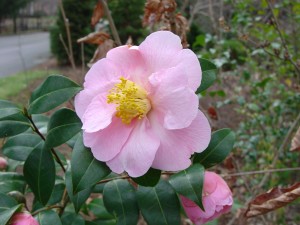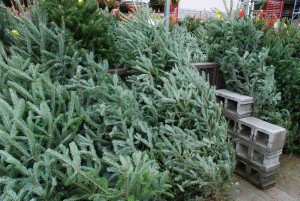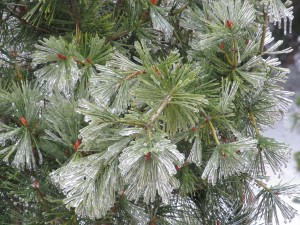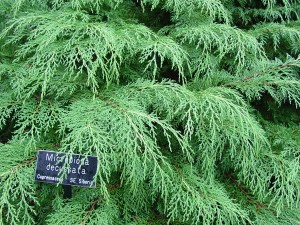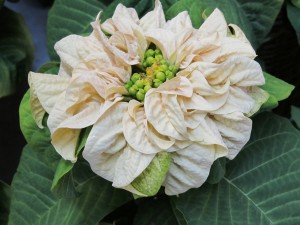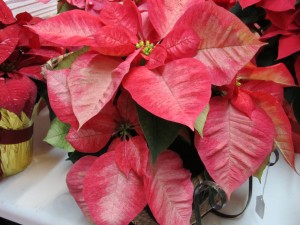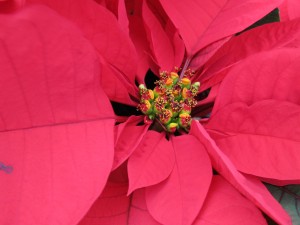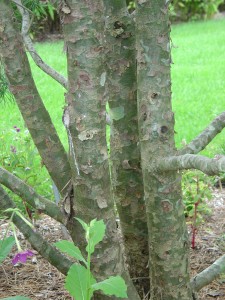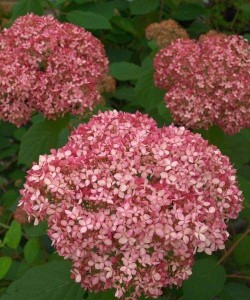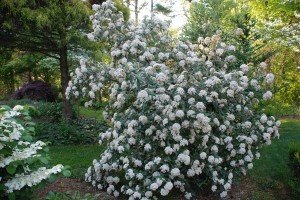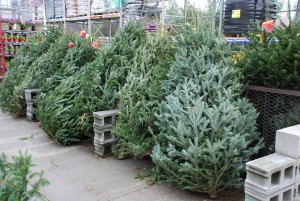Hardy Camellias — start with this one!
Recycle Live Christmas Trees
The holidays are over. This year take your live Christmas tree to a designated location to be recycled. Many cities and towns collect trees which are chipped into mulch. The mulch is spread around municipal park trees and street trees. It is utilized for erosion management along stream banks and on steep slopes. Mulch is also distributed to gardeners in the spring.
Communities pile up recycled trees as protective habitats for birds and other wildlife. Whole trees may be deposited into lakes and ponds as fish habitats, particularly for bottom feeders. Along fragile coastal areas trees are used to protect and restore dune areas.
Recycled trees protect newly planted young saplings from severe winter winds and serve as snow breaks in forests and park plantings. They also prevent deer and other varmints from feeding on newly planted tree seedlings.
Regarding trees to be recycled, here are a few caveats:
- Remove the stand and all decorations (lights, tinsel, ornaments, plastic garland, all metal items)
- Whether recycled or for curbside pickup, don’t wrap tree in a plastic bag
Many local communities advertise special drop-off points or collection times for discarded holiday trees. Check your local newspaper, city website or community recycling center for information. If tree recycling is not offered, maybe you and some friends can help organize one.
Ice Storm- Keep Hands Off
An ice storm is both a beautiful and horrific scene in a garden. The potential for major tree/shrub breakage is staggering. If you feel powerless, this is good thing. During the storm, do nothing / “hands off”. Most actions will likely cause more damage than what nature may have intended.
After the storm assess the landscape areas which seem most vulnerable, or that trouble you most. Next, hire an ISA* certified professional arborist to fit your landscape into his/her schedule. At the time of the storm, arborists are likely much too busy with emergency callers.
First on your list should be large trees not pruned in many years. They are likely shedding diseased, pest ridden, or broken limbs. Weak wooded species like silver maple (Acer saccharinum), sycamore or planetree (Platanus spp.), Bradford pear (Pyrus calleryana), poplars (Populus spp.), and willow (Salix spp.) seek to always drop anything from small twigs to large branches. Large evergreens like white pine (Pinus strobus) and leyland cypress (Cupressocyparis x leylandii) frequently deposit broken branches following stormy weather.
Ironically, the trees suffering the worse damage are those topped by neighbors and utility companies. The re-growths are very weak and snap off when the ice load reaches critical mass. Properly pruned trees ride out most ice storms. Take care of your trees and trees take care of you.
*International Society of Arboriculture
Try Microbiota Instead of Ground Junipers
Microbiota (Microbiota decussata) goes by numerous names including Russian arborvitae and Siberian cypress. This tough customer hails from Siberia, and quite cold hardy to -40 F. In the northern U.S. its lacy evergreen foliage turns brown in the dead of winter.
Here in the Southern Appalachian region, microbiota prospers in cooler parts of zone 6 and is troubled by summer heat and heavy clay soils in zone 7. Its medium green summer foliage develops a purple to bronze cast in winter. Spring warm-up restores its green needle color. Growth rate is slow to medium. Adjacent to my driveway microbiota cascades over a low retaining wall.
Substitute microbiota where you routinely plant ground cover junipers. Low growing microbiota ranges 10-12 inches in height and spreads from 6-8 feet in width. It is tolerant of dry shade. Deer and most disease and insect pests don’t bother it. It enjoys good soil moisture drainage and cool temperatures, and tolerates windy exposed sites once it becomes fully established.
Microbiota is not commonly sold at local garden centers, but may be purchase at specialty evergreen nurseries or through internet commerce. Plant container grown nursery stock in the late winter or early spring, mulch, and irrigate when natural rainfall is abnormally low.
Care of Your Poinsettia in the Home
You’ve purchased a beautiful poinsettia and want to give it a proper home for the holidays. Room light, temperature and soil moisture are the key environmental concerns.
Place your poinsettia either in a bright sunlit room or one receiving an indirect lighting source. Keep the plant away from heating vents and drafty windows.
In general, poinsettias grow trouble free in today’s modern homes for 4-5 weeks with room temperatures between 68 and 76 °F. Winter heating results a low room humidity and daily light spritzing around plants will help. But limit the amount of mist directly hitting plant foliage to avoid mildew disease problems.
Thoroughly water your poinsettia every 5-7 days. A more accurate watering method is to poke your finger into the pot to “feel” soil dryness. Or every 2-3 days, simply pick up the plant to calculate its weight and moisture needs. If your poinsettia weighs nearly the same from one week to the next, it may have a root problem.
By mid-January the lower leaves may begin shedding. The tasks of repotting and feeding your poinsettia may be in your future. From this point on, you may decide to pitch the poinsettia or attempt to revive it.
Future blog– more on upkeep and re-blooming your poinsettia to follow in early January.
Purchasing The Perfect Poinsettia
One of three posts on poinsettia care:
Poinsettias delight the eye at this holiday season with their bright red (and many other color choices) leaf-like bracts. The true flowers are the small multiple buds at the base of the bracts.
To select a top quality plant, closely inspect the development of the small flowers. Buds should tightly closed or barely showing few yellow stamens (photo). Once the flowers have fully opened and dried, your poinsettia’s overall health declines.
Before purchasing, inspect the stems and leaf undersides for insects and insect. Don’t buy plants which have pests. The plant foliage should be dark green throughout. If bottom leaves are starting to yellow, don’t buy. The plant should also stand on its own and not be staked or wired.
Don’t shock or damage in transit to your home or a friend’s home. Pre-heat your car and pull up to the door before carrying out the plant from the store.
Next post— “Care of Your Poinsettia in the Home”
Hydrangea Invincibelle Spirit ®
Hydrangea Invincibelle® Spirit ranks as one of the finest new plant introductions in 2010. This hydrangea comes from a good bloodline. Invincibelle® Spirit is a pink flowering clone originating from Annabelle. The cultivar ‘Annabelle’ (Hydrangea arborescens ‘Annabelle’) has been a star in Southern Appalachian gardens (USDA hardiness zones 6 and 7) for the past quarter century.
Invincibelle® Spirit grows in a wide variety of well-drained soils. It adapts to many light regimes in the garden from full to partial sun. The 3- to 4- foot tall shrub blooms on new or current season’s wood.
Annual pruning is simply to cutback plant height to 8-12 inches before new growth begins in early spring. Fertilize established shrubs in early spring using 10-10-10 or equivalent. Irrigate new plants weekly and established shrubs over prolonged dry spells.
One dollar from each plant sold is donated to the Breast Cancer Research Foundation. The goal of the U.S. Nursery Industry is to raise $1 million in the mission to find a cure in our lifetime. The National Cancer Institute estimates that 1 in 8 women will be diagnosed with breast cancer during their lifetime.
Update (December 2012). Since 2009, more than $472,000 has been raised since Invincibelle Spirit was introduced.
December Garden Classic – Prague Viburnum
Garden Classics: a monthly retrospective featuring a singular plant species either under-planted or relatively unknown to gardeners living in the Southern Appalachian Region.
Prague viburnum (Viburnum x pragense) is a lovely evergreen shrub, which combines all the best traits of its parents (V. rhytidophyllum and V. utile). It is winter hardy throughout the Southern Appalachian region (USDA zones 6 and 7). As the name indicates, this hybrid viburnum hails from the Czech Republic. It grows rapidly to a mature height and spread of 8 – 10 feet.
The rose pink colored floral buds begin to open in early May and lightly fragrant, creamy white flowers bloom for 2-3 weeks. Its lustrous dark evergreen foliage is comprised of 2 – 4 inch elliptical shape leaves. Prague viburnum is a teriffic stand alone specimen shrub or you may group several as a hedge or privacy screen. It serves as an effective foil against peering or noisy neighbors when planted in one or more rows 6 – 8 foot apart.
Plant in any moderately drained garden soil and in a full sun to partial shade exposure. Disease and insect pests seem to leave this viburnum alone. Moderate resistance to deer feeding is reported, perhaps useless information if the deer are hungry.
Rarely do I pruned my 15- year old Prague viburnum, only when it attempts to crowd out a nearby shrub in my admittedly overplanted garden.
Choosing a Cut Christmas Tree
Fire safety in the home should be your primary concern when purchasing a freshly cut Christmas tree. There are numerous “choose and cut” Christmas tree growers in the Southern Appalachian region (USDA zones 6 and 7). Trees are harvested by the tens of thousands in the mountainous locales and are shipped nationally and internationally. You can also purchase a tree from a large chain store or a local tree lot.
The evergreen species with best needle retention include: fraser fir, douglas fir, and balsam (Canaan) fir, followed by white pine and Scotch pine. Norway spruce rates the poorest in needle retention. Canadian or the western U. S. growers ship Balsam fir and Douglas fir trees into the region in time for post Thanksgiving sales. These trees are harvested 4 – 6 weeks ahead because of shipping and weather concerns.
When shopping at a tree lot, shake or bounce the tree to check needle retention. Needles should be soft and fragrant.
Re-cut the base (butt) of the tree, removing at least 1 inch prior to setting it into a stand indoors. Secure the tree and fill the water reservoir. Inspect the reservoir daily for water uptake. A freshly cut 6-7 foot tree may consume a 1/2 pint (8 oz.) or more of liquid per day.

